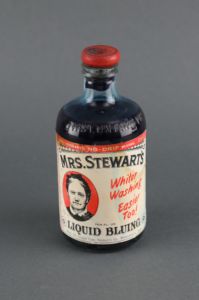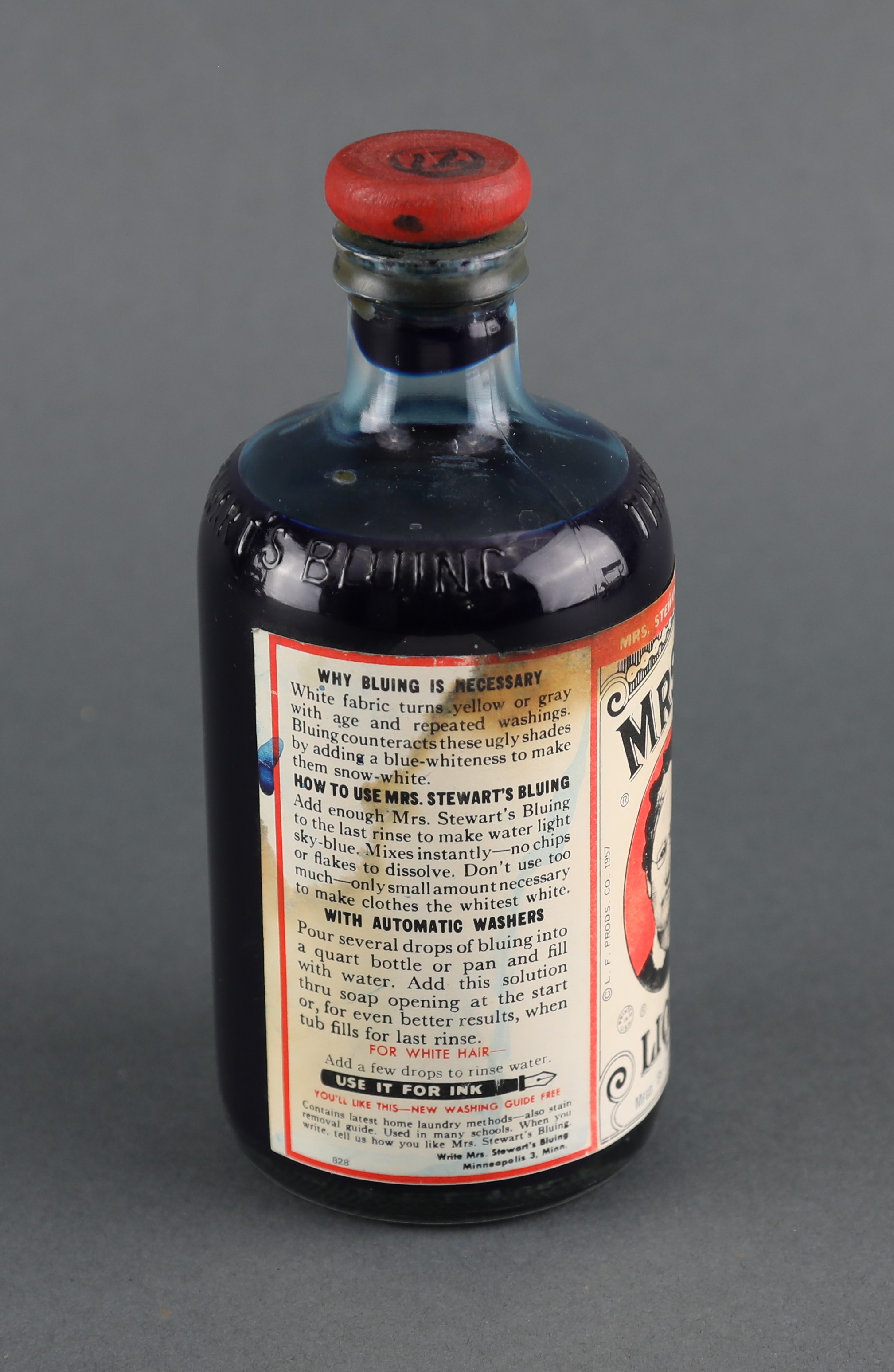September 17, 2018

This bottle of liquid bluing was once ubiquitous in homes across America. The first sale of Mrs. Stewart’s Bluing (MSB) was recorded on July 30, 1883. It is still sold and distributed today and has been manufactured in Hennepin County for the entirety of its long and interesting history.
In the 1870s, Al Stewart was a traveling salesman throughout the Midwest. One of the products he sold was a bottle of liquid bluing that his family made at home using his proprietary formula. At this time, Minneapolis resident Luther Ford had opened the first five and dime store west of Pittsburgh. These two gentlemen met while Stuart was looking for someone to manufacture his bluing. Stewart sold the rights to MSB to Ford, who immediately made plans to distribute the product more widely.
In 1910, Ford’s son Allyn joined the business. Not long after that, Robert Ford also began working for his father, and the two brothers devoted all their efforts to distributing MSB. At that time, profits were generated by salesmen who worked out of Minneapolis. In 1918, the salesmen were replaced by food and grocery brokers. By 1925, business had grown so rapidly and steadily they added five additional factories across the United States and Canada. Sales reached their highest point in 1946. In the 1950’s, Luther Ford’s grandson, also named Luther, took over the family business from his father and uncle. He ran the business through the seventies. MSB has had a few more owners since that time, but they still consider themselves to be an “old-fashioned family business.”
All MSB production has returned to Hennepin County, moving from their original factory location in Minneapolis, to their current location in Bloomington in 1986. Sales have decreased over the past fifty years due to bluing being replaced by bleach for laundry purposes. However, bluing serves a variety of other purposes including hair care, textile dyeing, window cleaning, and as an essential ingredient in a “Salt Crystal Garden.” Today MSB still has a loyal following. In fact, that’s why the bottles that are sold today are essentially the same bluing that was sold in the 1880s.
The main change to the product over the years has been the packaging. In the beginning, MSB glass bottles were hand-blown. Then in 1907, the bottles began to be manufactured automatically. The bottles were capped with imported Portuguese corks that were specially designed for MSB. Red wood tops were then hand-glued to these corks. By 1962, plastic caps replaced the wood and cork ones. Then in 1970s, MSB began to replace the glass bottles with plastic. The glass bottles with red tops, (like the one we have in our collection from 1957), are now a rare collectors’ item.

With the evolution of the bottle came some changes in the label. However, the image of the stern looking woman has been a constant. Before MSB was sold to Ford, Stuart was attempting to have a commercial label for his product made. The printer advised him to include an image of an older woman on the label to encourage sales. Stuart originally asked his wife for a photo of herself, but she refused. According to their story, Stuart in turn grabbed a photograph of his wife’s mother off their mantle and submitted it to the printer. This means that the famous image on bottles of MSB are not actually the real Mrs. Stewart, but her mother instead.
Since the first official sale of MSB in 1883, the company’s history has been one of innovative business development for a product that has remained mostly unchanged in 135 years. The company even quotes the old saying, “If it ain’t broke don’t fix it.” They also obviously recognized the merit in continuing to keep the manufacturing of their product in Hennepin County, and given the longevity of Mrs. Stewart’s Bluing, they must be doing something right.
Written by Alyssa Thiede
Our Mrs. Stewart’s materials were inventoried and cataloged as part of our larger collections inventory project. This publication was made possible in part by the people of Minnesota through a grant funded by an appropriation to the Minnesota Historical Society from the Minnesota Arts and Cultural Heritage Fund. Any views, findings, opinions, conclusions or recommendations expressed in this publication are those of the authors and do not necessarily represent those of the State of Minnesota, the Minnesota Historical Society, or the Minnesota Historic Resources Advisory Committee.

